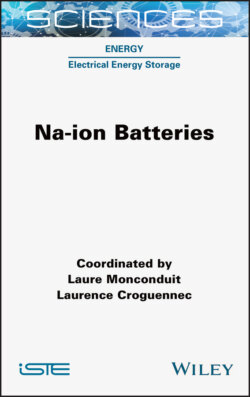Читать книгу Na-ion Batteries - Laure Monconduit - Страница 19
1.1. Research history of layered transition metal oxides as electrode materials for Na-ion batteries until 2009
ОглавлениеStudies on room temperature Na-ion batteries started in the 1970s and electrochemical properties of Na//NaxCoO2 and Na//TiS2 cells were reported in 1980 (Braconnier et al. 1980; Newman Klemann 1980) when properties of Li//LiCoO2 were also first reported (Mizushima et al. 1980). The Li-ion batteries commercialized by Sony in 1991 consisted of LiCoO2 as a positive electrode material and carbon as a negative one, and have attracted much attention as high-voltage rechargeable batteries to date. On the other hand, Na-ion batteries are essentially based on the same chemistry and technology as Li-ion batteries, except for the charge carriers as Li+ and Na+ ions. Na-containing (sodiated) and Na-free (desodiated) materials are used for positive and negative electrodes, respectively, which correspond to the discharge state of the battery. The working voltage of the Na//NaxCoO2 cell was, however, ca. 1 V lower than that of the Li//LiCoO2 cell, resulting in lower energy density (Goodenough et al. 1980). Allied Corp. in the United States and Showa Denko K. K. and Hitachi, Ltd. in Japan undertook collaborative work on Na-ion batteries and filed patents of Na-Pb alloy//γ-NaxCoO2 cells (Shacklette et al. 1985, 1988; Shishikura et al. 1989) exhibiting good cycle stability but commercialization of the Na-ion batteries has not been achieved so far. The Na-Pb alloy//γ-NaxCoO2 cells needed a pre-sodiation process for the Pb negative electrode. A primary drawback of Na-ion batteries was the fact that the pre-sodiation process was required for practical use of any negative electrode materials at that time. In the 2010s, there was a general consensus that non-graphitizable carbon, so-called hard carbon, is known to deliver large reversible capacities and good capacity retention without any pre-sodiation (Stevens and Dahn 2000; Komaba et al. 2011).
Thus, another issue of the practical use of Na-ion is the low working potential of the positive electrode materials. The voltage of NaCoO2, isostructural to α-NaFeO2, in a Na cell at the voltage plateau region close to the end of discharge is ca. 2.5 V and much lower than ca. 3.9 V for α-NaFeO2 type LiCoO2 in a Li cell as shown in Figure 1.1. The large difference cannot be explained only by the standard redox potential of Na metal, which is lower than that of Li metal by ca. 0.3 V (Marcus 1985; Komaba et al. 2015). The voltage difference is much smaller than that between NaxCoO2 and LiCoO2 at the end of discharge (ΔV = ca. 1.5 V) (Kubota et al. 2014). The large voltage difference is probably due to larger ionic size and lower Lewis acidity of Na+ in comparison to Li+ as discussed by Goodenough et al. (1980).
Figure 1.1. Comparison of charge/discharge curves for Li//LiCoO2 and Na//NaCoO2 cells. A schematic illustration of the crystal structure of isostructural LiCoO2 and NaCoO2 is also shown. Reproduced with permission from Yabuuchi et al. (2014). Copyright 2014, American Chemical Society. For a color version of this figure, see www.iste.co.uk/monconduit/batteries.zip
Since our group first demonstrated hard carbon//NaNi1/2Mn1/2O2 full cells exhibiting acceptable cycle stability in 2009 (Komaba et al. 2009) and the results were published in Advanced Functional Materials in 2011 (Komaba et al. 2011), yearly numbers of scientific papers on sodium batteries have rapidly increased (Kubota et al. 2018a) and significant efforts have been devoted to attaining high-voltage and high-capacity positive electrode materials for Na-ion batteries (Delmas et al. 1982; Pan et al. 2013; Slater et al. 2013; Xu et al. 2013; Yabuuchi et al. 2014; Clement et al. 2015; Kundu et al. 2015; Fang et al. 2016; Kim et al. 2016; Deng et al. 2017; Hwang et al. 2017b; Ortiz-Vitoriano et al. 2017).
Figure 1.2. Average voltage (V) and energy density (Wh kg−1) versus gravimetric capacity (mAh g−1) for selected positive electrode materials for Na-ion batteries. Energy density was calculated with the hard carbon (reversible capacity of 350 mAh g−1 with Eave = 0.3 V vs. Na metal) as negative electrode materials. Reproduced with permission from Kubota et al. (2018b). Copyright 2018, Wiley-VCH. For a color version of this figure, see www.iste.co.uk/monconduit/batteries.zip
Figure 1.2 shows a comparison of reversible capacity and working voltage among the positive electrode materials. The positive electrode materials for Na-ion batteries can be basically categorized into layered oxides, polyanionic compounds, and Prussian blue analogues. Polyanion materials seem to exhibit relatively higher working voltage and smaller capacities compared to the others. However, the high-voltage polyanion materials typically contain costly cobalt (Nose et al. 2013) or vanadium (Jian et al. 2012; Kang et al. 2012; Lim et al. 2014; Zhang et al. 2016) except for Na2Fe2(SO4)3 (Barpanda et al. 2014). On the other hand, Na-containing layered transition metal oxides exhibit relatively lower working voltage but larger capacities on the basis of redox activity of Fe3+/Fe4+ or manganese Mn3+/Mn4+. Because of the high-performance redox of iron and manganese, abundant mineral resources of iron and manganese are available, and the resultant cost-reduction will be thus advantageous for stationary applications of Na-ion batteries. We emphasize that the layered transition metal oxides meet this important demand for future application. Of course, higher energy density (i.e. large capacities and high working potential), long-term cycle life, high coulombic and energetic efficiencies, thermal-stability, and ease in handling and production, toxic-free chemistry and so on are desired for the practical use as positive electrode materials for Na-ion batteries.
In this chapter, developments of Na-containing layered 3d transition metal oxides are reviewed for the application as active materials of Na-ion batteries based upon the authors’ experience since 2003 (Komaba 2019). The electrochemical performances, phase transitions during the charge/discharge, surface chemistry in the batteries, key factors influencing the battery performances and future prospective are discussed mainly based on our leading studies on the layered oxides since 2005.
